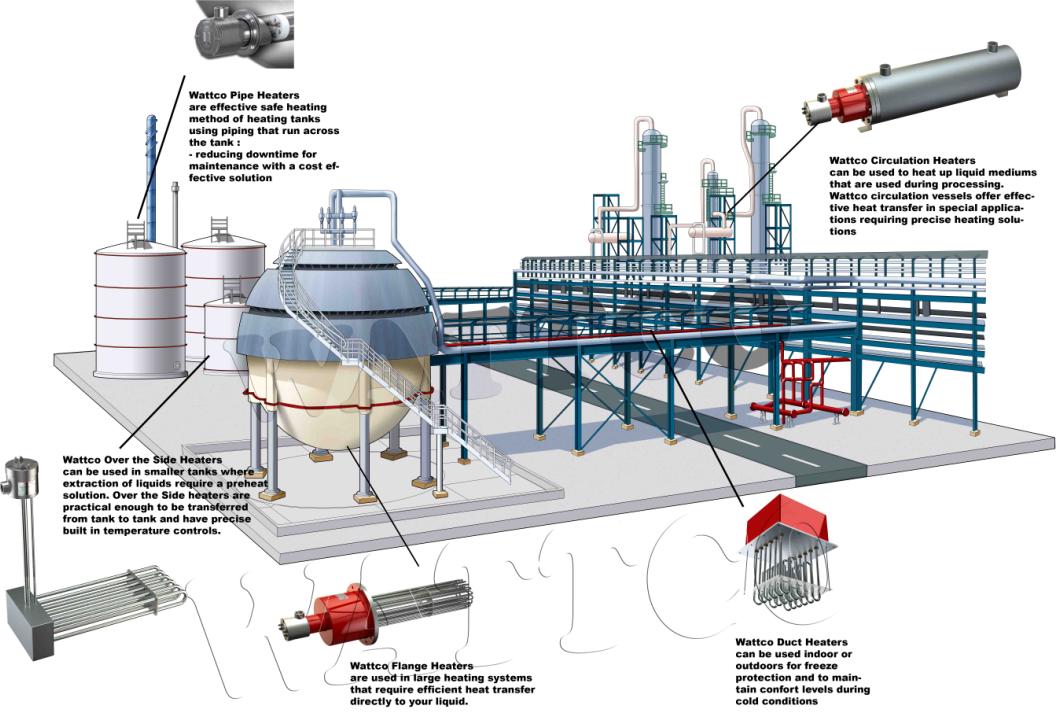The Uses of Immersion Heaters in the Nuclear Power Industry
In the case of a nuclear power plant, the initial heat for vaporization is provided by the controlled splitting of uranium atoms in a fission reactor.
This gives the following four-stage electrical energy production process:
1. The fission process in the reactor generates the heat.
2. The heat produced is absorbed by the coolant as it flows past the fuel, converting the nuclear energy to thermal energy.
3. The heated coolant is then transferred to the steam generator tubes where the excess heat causes the surrounding feed water to boil and produce steam for the secondary side of the steam generator.
4. The steam from the boiling feed water is transferred to turbines directly coupled to an electrical generator and the generated rotation produces electricity. After leaving the turbine, the steam is passed to the main condensers for condensation and then to a feed pump. This pump increases the pressure of the feed water and returns it to the steam generator and the cycle is repeated.
The majority of current reactors in service are either boiling water reactors (BWR) or pressurized water reactors (PWR). In a BWR the water, which acts as moderator and coolant, passes over the reactor core and also provides the steam source for the turbine. This can result in radioactive water that could contaminate the whole loop.
In addition, while the typical operating pressure for a BWR is approximately 70 atmospheres, which boils water at about 285°C giving a Carnot efficiency[ii] of only 42%, a PWR can operate at higher pressure and temperature, about 160 atmospheres and 315°C– providing a higher Carnot efficiency than the BWR.
Nuclear energy production requires a multitude of control systems to monitor and adjust the many parameters that are critical to the process. Many of these control systems require electrical heat generation, and immersion heaters are an ideal solution. Immersion heaters release all their heat directly into the fluid, making them almost 100% energy-efficient. They are normally used when there is a requirement to maintain the temperature of a liquid to a specified controlled point.

Figure 1 shows some of the heat and control applications required in a typical PWR power station.
As seen from Figure 1, there can be a lot of requirements for immersion heaters in a nuclear power station system, including:
Circulation heaters to warm coolant for stand-by and emergency generators.
ñ Circulation heaters per-heat fuel oil for stand-by / emergency generators.
ñ Immersion heaters to warm the oil for lubrication of bearings and moving components.
ñ Immersion heaters to provide heat input to ensure precise temperatures needed for process conditions in the Hydrogen Storage.
ñ Pressurizer heaters to heat and maintain water in the primary loop at the operating temperature and pressure required by the pressurized reactor vessel.
ñ Circulation heaters to prevent the freezing of the liquids used in the containment cooling system and storage tanks.
ñ Immersion heaters to provide freeze protection and temperature maintenance for the Generalized Water Storage.
ñ Circulation heaters to provide temperature control for refueling water, make-up water, and plant water usage.
ñ Immersion heaters to provide the extra heat needed to maintain condensate return temperature.
There are several basic immersion heater configurations. The flanged and circulation, sometimes called in-line, immersion heaters are of the most interest to the thermal power industry.
Flanged immersion heaters are the best type of heater for the pressurizer vessel of PWR reactors. They are easy to install, highly efficient, and easy to maintain compared to other types of heaters. Because of the high temperature and pressure conditions, plus the constant nuclear irradiation, stainless steel is considered the best material for the elements in such immersion heaters. However, companies like WATTCO [iii]also supply alloy compositions, such as Incomer® and Incontinent®, with heavy-walled sheaths specifically designed for high-wattage applications–such as the heating of the pressurizer in PWR reactors.
Also read: Applications and Considerations For Air Intake In Nuclear Power Plants
The flanged immersion heater contains a circular or flat tubular heater that is fixed to a flange wit, four or six studs and terminals for connecting wiring. Flanged heaters are bolted directly to an associated flange fixed to the wall of the tank or to a nozzle. This makes changing easy, as you only need to unbolt the heater and mount a new one, and helps minimize maintenance downtime.
Circulation, or in-line heaters are ideal for processing fluids that require intermediate heating while maintaining a flow rate. They are self-contained units, with the heater wrapped in an insulated tank. These heaters have inlet pipes and outlet pipes allowing the fluid to flow through the tank until it has been heated to the required temperature.
This type of immersion heater is extremely responsive and provides an even distribution of heat. It is also easy to install, maintain, and is compatible with the majority of the current standard industrial piping.
